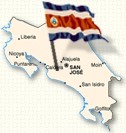 |
 GEOGRAPHY & CLIMATE: Located in Central America, Costa Rica is situated between Nicaragua and Panama and its coast stretches between two oceans, the Atlantic (Caribbean Sea) and the Pacific. The Atlantic coast has heavy rainfall, while the Pacific coast is much drier. The central uplands are temperate. The population is 3.5 million. COFFEE BACKGROUND: The first coffee trees were introduced from Cuba in 1779. Today, most of the coffee is grown in the mountainous regions of the Central valley and along the Atlantic and the Pacific slopes. The government recently has introduced environmental regulations which has helped to reduce the water pollution and improve the overall coffee milling process. And this has led to direct improvement in the quality of coffee coming out from Costa Rica. SPECIES: Arabica ALTITUDE AT WHICH GROWN: 2,500 - 5,000 ft. PREPARATION METHOD: “Washed” ANNUAL PRODUCTION: 2,760,000 bags (99-00 crop) SHIPMENT PERIOD: November - June TYPES OF COFFEE OFFERED: Costa Rica SHB Euro Plus: Grown in the Tres Rios area on the fertile mountainous slopes towards the Pacific coast, this coffee is one of the finest from Costa Rica. It has a very bright sweet flavor with good body and lively acidity. Personal Comments: 9/20/98: Costa Rica was the first Central or South American country I visited
since coming |
|
|
©Moledina Commodities Inc. - (All Rights Reserved) |